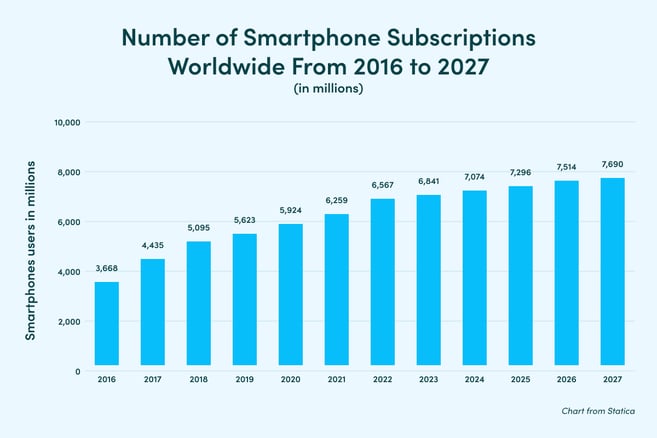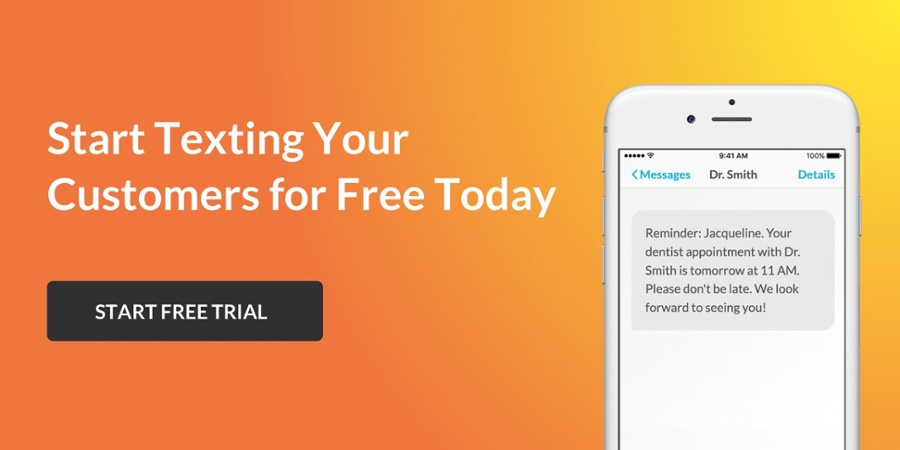Many of us can’t begin to imagine life without our smartphones. They’re everywhere– more than 80% of Americans rely on smartphones to talk, send and receive texts, browse the web and even conduct business.
Yet the smartphone as we know it is a relatively new invention. Smartphones couldn’t always recognize our faces, enable video chat with friends worldwide, take high-res photos or effortlessly browse the internet.
So how did we get here? When were smartphones invented? In this blog, we’ll walk you through the fascinating evolution of these tech marvels.
Table of Contents
-min.jpg?width=1200&height=800&name=TXT-688-blog%201-1%20(1)-min.jpg)
1973: The First Cell Phone Is Invented
Cellular phones preceded smartphones on the road to portable digital technology. Motorola’s Martin Cooper made the first cell phone call in April 1973. While carrying portable phones was not realized for ten more years, this development paved the way for further advancements in mobile communications.
1984: The First Portable Mobile Device
Almost 40 years ago, Motorola debuted the DynaTAC 8000X – the first mobile phone. With a price tag of $4,000, it was never destined to become a must-have for the general population.
It was clunky, weighing in at a whopping two pounds, earning its nickname “The Brick.” Its battery life? 30 minutes.
The DynaTAC 8000X was mostly a status symbol. Nonetheless, it represents a big step in the evolution of the smartphone. So when did smartphones come out?
1992: The First Smartphone
IBM announced the first smartphone in 1992, which wouldn’t be available for purchase for two more years. The Simon Personal Communicator (or SPC, commonly called IBM Simon) included many features familiar to modern smartphone users, such as a touch screen that required a stylus (a what?). However, proper touch screens were still more than a few years into the future.
However, with a small monochrome LCD screen and a one-hour battery life, the SPC was still relatively primitive compared to today’s smartphones.
1994: The Earliest Form of Smartphone Apps
IBM Simon finally hit the market in 1994. With a price tag of $1,100, it was significantly cheaper than the DynaTAC 8000X but only sold about 50,000 in its first six months. In addition, its use was pretty limited – it only worked in 15 U.S. states. And while it wasn’t as bulky as earlier phones, the SPC was still big and boxy.
One of the more revolutionary aspects of the SPC was that each phone came with a calendar, address book, calculator, email, notepad and other features.
Mobile applications had arrived.
1997: The Start of Mobile Gaming
Do you love Wordle? Or is Roblox more your style? In 1997, your options for mobile gaming were much more limited.
Starting that year, Nokia 6110 users could play Snake, a game developed by Finnish software engineer Taneli Armanto. It was a simple, family-friendly game, so people quickly became hooked. Snake started the mobile gaming industry, now worth over $152 billion.
Ericsson coined the term “smartphone” in 1997 to describe their GS88, a prototype device that never reached the market – ten years before the iPhone’s debut.
2000: The First Camera Phone
At the start of the new millennium, Sharp introduced the world to the wonders of the camera phone. Although the J-SH04 was limited to Japan, it represented the start of a love affair between phone users and photography.
And weighing just four ounces, the J-SHO4 was one step closer to today's sleek and slim phones.
Not surprisingly, the photo quality was nowhere near what modern smartphone users have come to expect: Its camera was only 110,000 pixels.
By comparison, the iPhone 14 camera has three rear cameras, with a 48-megapixel main camera. The J-SH04’s camera was also back-facing – the era of the selfie was still to come.
2001: Cell Phones Access the Internet
Finally, smartphones and the Internet meet. For the first time in 2001, smartphones could connect wirelessly with a 3G network. This capability opened up a whole new world to smartphone users, who could now send email attachments and video conference with their mobile devices.
This evolution didn’t come cheap, however. Although mobile devices were now around $300-$700, the cost of data proved inaccessible to most users.
2007: Apple Takes a Bite of the Smartphone Market
2007 was a game-changer for smartphones. Steve Jobs announced the world’s first iPhone at January’s Macworld convention. The first iteration included a touchscreen, iPod, camera, full internet access capabilities (a first!) and a wide LCD screen designed for video. It was sleek, lightweight and available in 4GB ($499) and 8GB ($599) models.
Another groundbreaking aspect of the iPhone was its software capabilities. Soon, users could download millions of third-party applications, limiting the iPhone’s capabilities only to the imagination of software developers.
Jobs wasn’t wrong when he described the iPhone as a “revolutionary and magical product that is literally five years ahead of any other mobile phone.” It was, far and away, the most advanced smartphone the world had seen. In its first year on the market, upwards of 1.4 million iPhones were sold.
By 2008, that number would reach a truly impressive 11.6 million. Apple has now launched 38 new iPhone models, and the world has never looked back.
2008: The First Android Smartphone
The first Android smartphone was the HTC Dream, also known as the T-Mobile G1. A collaboration between HTC and Google, it ran on Android 1.0, the first version of the Android operating system.
The HTC Dream featured a 3.2-inch touchscreen display, a slide-out QWERTY keyboard, and a 3.2-megapixel camera. The HTC Dream was the first device to feature the Android Market, which later became the Google Play Store. It was a groundbreaking device that marked the beginning of the Android era, and it paved the way for the many Android smartphones that followed.
2020: The Modern Smartphone
The iPhone’s debut revolutionized smartphones and triggered a domino effect of rapidly advancing features and capabilities. It was a true turning point in smartphone history.
Modern cell phones have more memory, speed and power than previously imaginable, and countless apps have become available and monetized.
We’ve seen incredible advancements in almost every aspect of the smartphone. For example, smartphone cameras take professional-quality pictures (including selfies) and stream music, videos and games effortlessly. In addition, 24/7 access to social media on the go has forever changed our relationships and interactions.
Read more: What Is the Future of SMS Marketing?
2023 and Beyond: What’s Next?
So what’s next in smartphone technology? Wireless charging and foldable phones are already here, along with augmented reality, real-time language translation and increased 5G-enabled connectivity.

The number of global smartphone users in 2023 is estimated at 6.9 billion and is expected to rise to 7.7 billion by 2027.
The rise of artificial intelligence will continue, with AI-powered personal assistants (think Alexa and Siri), and mega-fast media downloading speeds aren’t far behind. In addition, screen-only mobile devices – without ports or buttons – will force wide-range adoption of Bluetooth technology.
Read more: Text Marketing Trends to Watch For in 2023
Revolutionize Your Business Communications With Textedly
Text messaging hasn’t just changed consumer communication. The modern smartphone has revolutionized the way businesses and their customers communicate. Texting has become the preferred communication method, from marketing products and chatting with customers to generating leads.
If your company is stuck in the pre-smartphone era, it’s time to explore how you can benefit from using SMS to send bulk messages, promote services and earn new business.
Are you interested in learning more? Give Textedly a try. We’re a leading SMS marketing platform that provides simple SMS and MMS solutions for businesses of any size and industry.
Sign up for a free Textedly trial today!








.png)